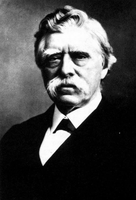










David Edward Hughes, was an Anglo-American inventor, practical experimenter, and professor of music known for his work on the printing telegraph and the microphone.Born in London, his family moved to the U.S. while he was a child and he became professor of music in Kentucky. In 1855 he patented a printing telegraph. He moved back to London in 1857 and further pursued experimentation and invention, coming up with an improved carbon microphone in 1878. In 1879 he identified what seemed to be a new phenomenon during his experiments where sparking in one device could be heard in a portable microphone apparatus he set up. It was most probably radio transmissions but this was nine years before electromagnetic radiation was a proven concept and Hughes was convinced by others that his discovery was simply electromagnetic induction. He was also a harpist.
Personal Life:
Hughes’s family emigrated to the United States when he was seven years old. In 1850 he became professor of music at St. Joseph’s College, Bardstown, Kentucky. Five years later he took out a U.S. patent for a type-printing telegraph instrument; its success was immediate, and in 1857 Hughes took it to Europe, where it came into widespread use and in some places continued in use until the 1930s. Hughes’s microphone, invented in 1878, was the forerunner of the various carbon microphones that were used in most telephones produced in the 20th century.
From 1879 to 1886 Hughes performed a series of experiments in which his equipment transmitted wireless signals up to 500 yards. The observed effects were attributed to induction by other scientists. Hughes disagreed but did not know how the transmissions were working. It was not realized until 1899, after German physicist Heinrich Hertz’s radio wave experiments in the late 1880s, that Hughes had been the first to produce radio waves.